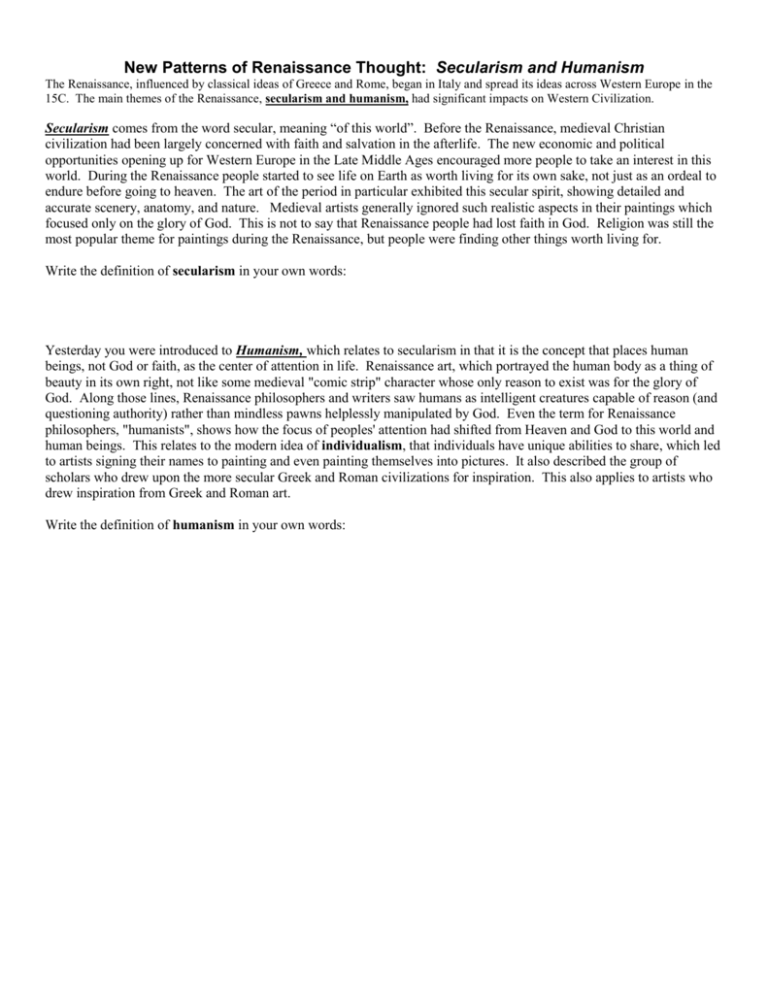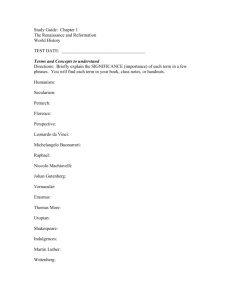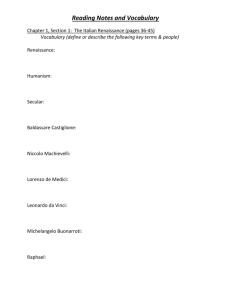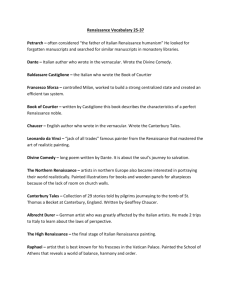Renaissance Art and Literature
advertisement

New Patterns of Renaissance Thought: Secularism and Humanism The Renaissance, influenced by classical ideas of Greece and Rome, began in Italy and spread its ideas across Western Europe in the 15C. The main themes of the Renaissance, secularism and humanism, had significant impacts on Western Civilization. Secularism comes from the word secular, meaning “of this world”. Before the Renaissance, medieval Christian civilization had been largely concerned with faith and salvation in the afterlife. The new economic and political opportunities opening up for Western Europe in the Late Middle Ages encouraged more people to take an interest in this world. During the Renaissance people started to see life on Earth as worth living for its own sake, not just as an ordeal to endure before going to heaven. The art of the period in particular exhibited this secular spirit, showing detailed and accurate scenery, anatomy, and nature. Medieval artists generally ignored such realistic aspects in their paintings which focused only on the glory of God. This is not to say that Renaissance people had lost faith in God. Religion was still the most popular theme for paintings during the Renaissance, but people were finding other things worth living for. Write the definition of secularism in your own words: Yesterday you were introduced to Humanism, which relates to secularism in that it is the concept that places human beings, not God or faith, as the center of attention in life. Renaissance art, which portrayed the human body as a thing of beauty in its own right, not like some medieval "comic strip" character whose only reason to exist was for the glory of God. Along those lines, Renaissance philosophers and writers saw humans as intelligent creatures capable of reason (and questioning authority) rather than mindless pawns helplessly manipulated by God. Even the term for Renaissance philosophers, "humanists", shows how the focus of peoples' attention had shifted from Heaven and God to this world and human beings. This relates to the modern idea of individualism, that individuals have unique abilities to share, which led to artists signing their names to painting and even painting themselves into pictures. It also described the group of scholars who drew upon the more secular Greek and Roman civilizations for inspiration. This also applies to artists who drew inspiration from Greek and Roman art. Write the definition of humanism in your own words: Assignment #3: Intellectual Revolutions – Major Themes of the Renaissance in Art & Literature Take notes below on how art slides & readings illustrate aspects of main themes of the Renaissance Renaissance Art Slides The Courtier by Castiglione S e c u l a r i s m H u m a n i s m The Ideal of the Well-Rounded Man by Castiglione The Greeks believed that a man ought to be “well-rounded” meaning that he should develop every aspect of his personality. Count Baldassare Castiglione, a sixteenth-century Italian diplomat, combined this ideal with new Renaissance ideals in a book called The Courtier. As the title implies, Castiglione was writing for the people in the courts of the nobility, but his ideas did influence the middle class merchants and craftsmen. After filling in the characteristics of a Renaissance Man, fill in your Humanism and Secularism chart. For this evening's game, let us select someone to portray a perfect courtier. He should explain all of the conditions and special qualities that a courtier must have; if he mentions something that is not correct, anyone may correct him… Since doing the same thing over and over again is tiresome, we must vary out life with different occupations. For this reason, I would have our courtier sometimes take part in quiet and peaceful exercises. If he is to escape envy and appear agreeable to everyone, the courtier should join others in what they are doing. Yet he should always be careful to do those things that are praiseworthy. He must use good judgment to see that he never appears foolish. But let him laugh, joke, banter, frolic, and dance, yet in such a way that he shall always appear genial and discreet. And in whatever he does or says, let him do it with grace. I would have the courtier know literature, in particular those studies known as the humanities. He should be able to speak not only Latin but Greek, as well. Let him read and know the Roman and Greek poets, orators, and historians. Let him be proficient in writing verse and prose, particularly in our own, vulgar language. Besides gaining enjoyment for himself, the courtier will find that his writings will also entertain the ladies, who are usually found of such things. If the courtier cannot attain perfection in this art, he should be careful to see that no one reads what he writes so that others will not laugh at him. Instead, he should show his writings only to a trusted friend. Even if he does not become perfect in the art of writing verse and prose, he should still practice it so that he will at least be able to judge the work of others. My lords, you must know that I am not content with the courtier unless he is also a musician. Besides being able to read and understand the music, he must be able to play the different instruments. Music is the best relaxation or medicine for a troubled man. Moreover, it is a most becoming and praiseworthy pastime during leisure hours, especially in the court, where it relieves the boredom and pleases the ladies, whose tender and gentle spirits are affected by the harmony and are failed with sweetness… I wish to discuss another matter, which I think is very important and should not be overlooked by our courtier. He should know how to draw and paint. Do not be surprised that I believe the courtier should know this art, which today seems to be practiced only by artisans and not by gentlemen. I remember having read that the ancients, especially in Greece, had the boys of noble birth study painting in school. They believed it was an honorable and necessary thing, and it was recognized as the first of the liberal arts. At the same time they forbade the slaves to practice the art. Among the Romans too, it was held in the highest honor… And truly one who does not honor this art seems unreasonable to me. This universe that we see-the vast heaven so richly adorned with shining stars, the earth circled by seas, varied with mountains, valleys and rivers and decorated with so many different trees, beautiful flowers and grasses-is a great and noble picture painted by the hand of nature and of God. Whoever is capable of copying these pictures in his own paintings seems to me to deserve great respect and notice. Characteristics of a Renaissance Man







